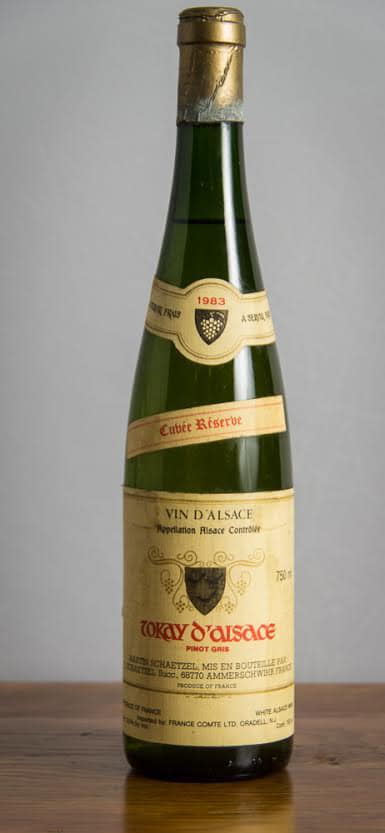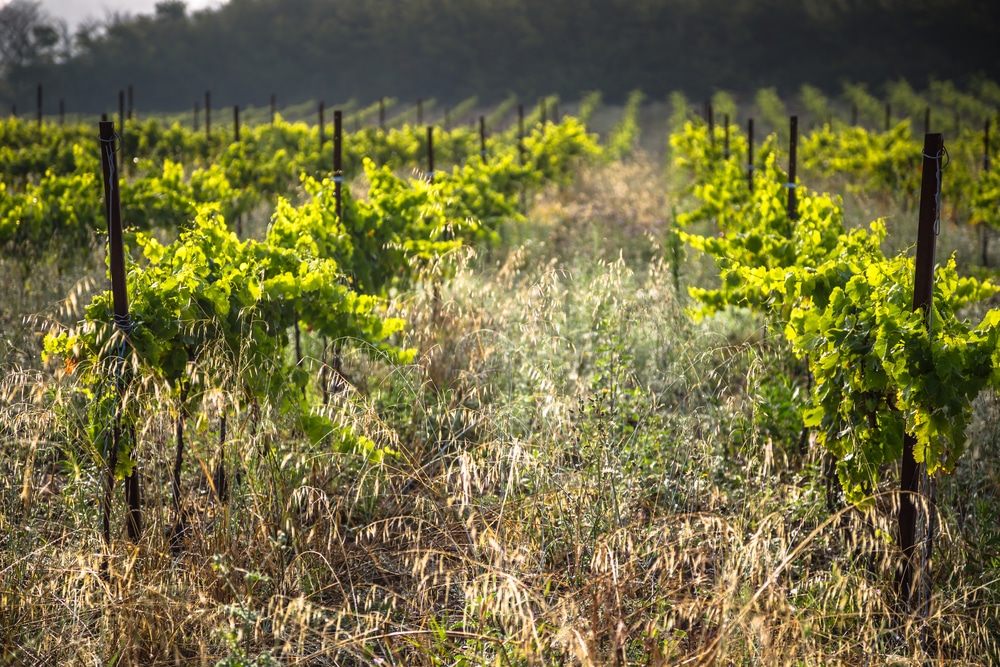1983 Martin Schaetzel Tokay d’Alsace

We opened this almost thirty-two-year-old bottle of white wine for a Mother’s Day dinner, May 10, 2015.
As has been the case with each old white I’ve characterized and written about as an “odd bottle,” this Alsatian wine defied its actuarial expectations.
It was golden in the glass, viscous, if I may use this word for a visual impression. And I use it because that’s how it looked – cloudy with time (talk about the “golden years!”), syrupy – and that was soon enough how it felt in the mouth. It was thick, smooth, and had the oily texture that’s considered a characteristic of this wine.
How did it smell? It smelled of honey, Meyer lemon, apricot, burnt vine shoots, green apple, beeswax, mango, mushroom, white peach, dried fruits, gingerbread, musk, pear, lime, forest floor, and, finally, from a different forest, moss.
I’m kidding! Those are just a few of the aromas associated with this wine, gathered from several websites. Who can smell all these sometimes contradictory aromas in a single wine? Not I.
I did smell honey, however. And tasted it too. The taste of honey is what many white wines provide when they get old. It doesn’t mean the wine is sweet. Often the wine is not only dry but ultra-dry (from Chenin Blanc, for example). This wine tasted like honey. But it didn’t taste sweet so much as…honeyed.
So what is this wine? What grape is it from? You get no answer from the wine’s label. (Alsace is the only wine region in France whose wines are customarily labeled by grape variety.)
It’s Pinot Gris. It’s from the same grape as Pinot Grigio, but the same grape doesn’t make the same wine. Try them side by side. You’ll see.
You may also realize that one of the greatest white wines in the world is Alsatian Pinot Gris.
It’s been called Pinot Gris since 2007. Before then, it was known, successively, as Grauer Tokayer, Tokay Gris, and Tokay d’Alsace (as here).
There’s a website that mistakenly calls this a white wine made from a red grape. Although Pinot Gris is indeed descended from Pinot Noir, and its grapes can be as dark as black and as light as white, it is a white grape whose color variations have led it to be called gris: gray.
But it’s not gray in the glass. In the glass, it’s the color of wildflower honey.
You’re unlikely to find in the United States a Pinot Gris made by the relatively small Domaine Martin Schaetzel. I bought this bottle in New York in the mid-1980s. It cost less than $10.* I kept it until Mother’s Day, 2015. However, there is much Pinot Gris readily available from such large producers as Trimbach, Hugel, Schlumberger, and Zind-Humbrecht. Some are as inexpensive as $11.
Others (vinified to be sweet) cost more than $100; for example, at $149, a wine whose name and opulence will fill your mouth to bursting: Zind-Humbrecht Tokay Pinot Gris Clos Jebsal Vendanges Tardives 1994. On Mother’s Day, we paired this 1983 Martin Schaetzel Tokay d’Alsace (and several other wines) with a huge grilled Portobello mushroom, chicken Marsala, and chicken piccata. It was perfect.
Eight nights later, and after having tested at home the same bottle for several of those nights, we drank the last of this seemingly everlastingly young wine with steamed lobsters. On that occasion, it matched wonderfully the, yes, sweetness of the dense, white meat.
* $10 USD (United States Dollar) at this writing equals 8.91 Euro, 10.23 CAD (Canadian Dollar), 10.29 AUD (Australian Dollar). ![]()
